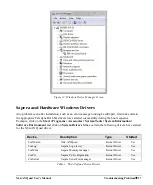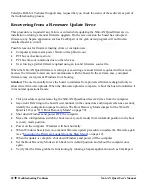
X64-AN Quad User's Manual
Theory of Operation
41
Single Pulse VS
Ext. Trigger
VS
VS
offset
VS
duration
Figure 22: Single pulse VS timing
Sapera parameters for VSync :
Refer to Time Integration method of Sapera documentation
CORACQ_CAP_TIME_INTEGRATE_METHOD:
Method to use for time integration
CORACQ_PRM_TIME_INTEGRATE_PULSE_DELAY:
Pulse offset from trigger event
CORACQ_PRM_TIME_INTEGRATE_PULSE_DURATION:
Size of pulse
CORACQ_PRM_TIME_INTEGRATE_PULSE_POLARITY =
{ CORACQ_VAL_ACTIVE_LOW, CORACQ_VAL_ACTIVE_HIGH}
External Trigger and Strobe
External Trigger
External Trigger allows image acquisitions to be synchronized to external events. With this mode
enabled, when the X64-AN Quad receives a trigger signal, the acquisition begins with the next valid
frame.
One external trigger signal is available per input. The same external trigger signal can be used to
synchronized acquisitions from multiple inputs. The external trigger input uses an opto-coupler for
isolation and protection. The trigger source must drive at least 2mA to turn on the opto-coupler.
Minimum voltage difference is 2V to turn on and 0.8V to turn off. The external trigger can be either
rising or falling edge. Maximum input differential voltage supported by opto-coupler is 24V.
The incoming trigger pulse is “debounced” to ensure that no voltage glitch would be detected as a
valid trigger pulse. This debounce circuit time constant can be programmed from 1
s to 255
s. Any
pulse smaller than the programmed value is blocked and therefore not seen by the acquisition circuitry.
Note:
If no debounce value is specified (value of 0
s), the minimum value of 1
s will be used.






























